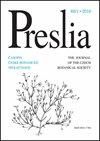从古生态重建的角度探讨保护目标
IF 4.4
2区 生物学
Q1 PLANT SCIENCES
引用次数: 8
摘要
我们分析了波西米亚-摩拉维亚高地(捷克共和国)保存最完好的泥炭沼泽的花粉、非花粉形态、地球化学和植物大遗骸的连续和准确的年代记录。Dářko泥炭沼泽是一个孤立的地点,松树沼泽林地主要是中欧特有的松亚种。uliginosa。它被保护为国家自然保护区和社区重要地点。我们描述了自晚冰期以来该遗址发展的主要模式和有趣的细节,并为一些具有高保护价值的自然现象提供了历史背景。直到中世纪盛期,宏观气候和自生演替似乎一直是当地和区域植被发展的主要驱动力。以松树为主的晚冰期植被和喜冷分类群一直存活到全新世的第一个千年。我国目前范围以外的Isoëtes湖的首次晚冰期和全新世记录表明,这一时期存在一个冷的寡营养水体。榛树、云杉和混合栎林分类群大约在10500年前就开始扩张了。在7700 cal. BP前后出现暖海洋性气候指标,AP:NAP比值逐渐增大,达到全新世最大值,接近99%。6800 cal. BP左右,微营养化湿地发育为疏营养化沼泽。云杉、Fagus和冷杉在5500 cal. BP左右开始占主导地位。在公元1100年到1350年之间,植被开始发生突变,这与中世纪对该地区的殖民统治相吻合。地球化学记录中Pb的峰值在公元1200 ~ 1650年之间,反映了该区广泛的冶金活动。有价值的松树沼泽林地在公元1500年左右出现,当时松树开始扩张。在其他地方也有记录,这种后期扩张可能是由人类活动引发的,这对目前对该栖息地的非干预管理提出了挑战。目前沼泽沼的边缘分布可能被认为是冰期晚期和全新世早期微营养化沼泽植被的遗迹,生态学报,42 (2):87 - 114,2020本文章由计算机程序翻译,如有差异,请以英文原文为准。
Conservation targets from the perspective of a palaeoecological reconstruction
We analysed a continuous and well-dated record of pollen, non-pollen palynomorphs, geochemistry and plant macroremains from the best preserved peat bog in the Bohemian-Moravian Highlands (Czech Republic). Dářko peat bog is an isolated site of a pine bog woodland dominated by the central-European endemic Pinus uncinata subsp. uliginosa. It is protected as a National Nature Reserve and a Site of Community Importance. We describe major patterns and interesting details of the development of this site since the Late Glacial and provide a historical context for some natural phenomena of high conservation value. Until the High Middle Ages, macroclimate and autogenic succession appear to have been the main drivers of both the local and regional development of vegetation. The pine-dominated Late Glacial vegetation with cold-loving taxa survived until the first millennia of the Holocene. The first Late Glacial and Holocene record of Isoëtes lacustris outside its present range in this country indicates the presence of a cold oligotrophic waterbody in this period. Corylus, Picea and mixed oak forest taxa started to expand already around 10,500 cal. BP. Indicators of a warm oceanic climate appeared around 7700 cal. BP and the AP:NAP ratio increased gradually up to its Holocene maximum close to 99%. Around 6800 cal. BP, the minerotrophic wetland developed into an ombrotrophic bog. Picea, Fagus and Abies started to dominate the pollen assemblage around 5500 cal. BP. Between AD 1100 and 1350, an abrupt change in the vegetation started, which coincided with the High Medieval colonization of the region. The pronounced peak of Pb in the geochemical record between AD 1200 and 1650 reflects extensive metallurgical activities in a wider area. Valuable pine bog woodland appeared only around AD 1500, when pine expanded. This late expansion, also recorded elsewhere, may have been triggered by human activities, which challenges the present non-intervention management of this habitat. The present marginal occurrence of fen species in the bog lagg may be considered a relict of Late Glacial and Early Holocene minerotrophic fen vegetation, the Preslia 92: 87–114, 2020 87
求助全文
通过发布文献求助,成功后即可免费获取论文全文。
去求助
来源期刊

Preslia
生物-植物科学
CiteScore
5.20
自引率
29.40%
发文量
8
审稿时长
>12 weeks
期刊介绍:
Preslia is a peer-reviewed scientific journal publishing original research papers on plant systematics, morphology, phytogeography, ecology and vegetation science, with a geographical focus on central Europe. The journal was founded in 1914 and named in honour of brothers Jan Svatopluk Presl (1791–1849) and Karel Bořivoj Presl (1794–1852), outstanding Bohemian botanists. It is published quarterly by the Czech Botanical Society.
 求助内容:
求助内容: 应助结果提醒方式:
应助结果提醒方式:


